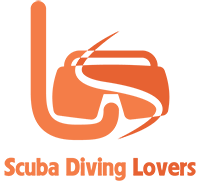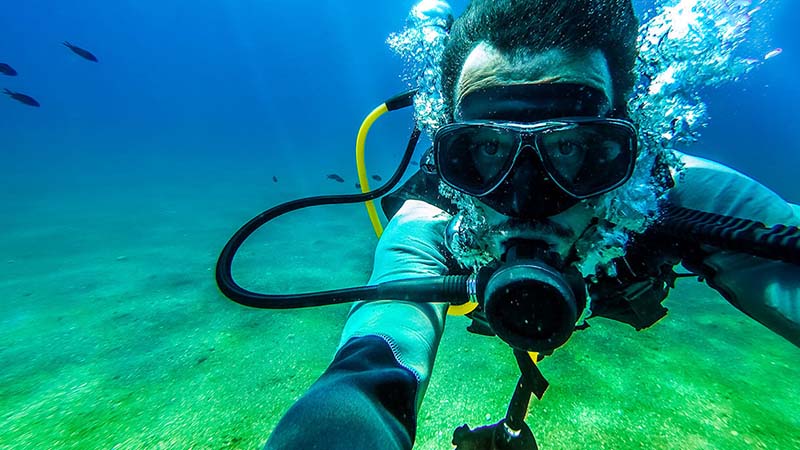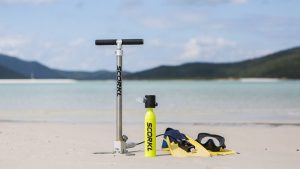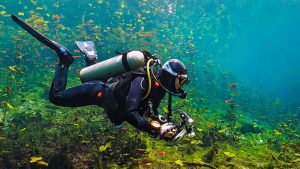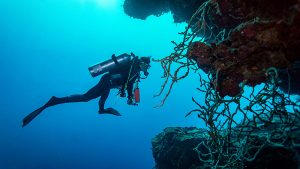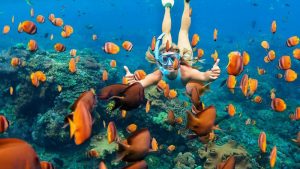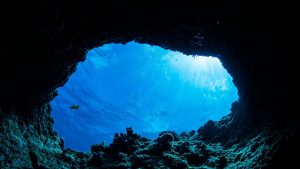What is the best regulator for scuba diving? Aqualung Core Supreme Scuba Regulator, Aqualung Legend, ScubaPro MK25…
We could go on and on. Some people will swear by a certain scuba regulator brand, other will swear against that. And so we can say, to each his own.
But that would be too casual. In any case, how good a regulator you have in the bowels of the ocean is a matter of life and death!
What I am trying to say is… You cannot dive without a diving regulator! Not unless you are a daredevil freediver.
But first, what is a scuba diving regulator? As the name suggests, this dive gear is going to standardize the pressure of the air coming from the scuba tank to the diver’s lungs. Buying one is easy, or hard depending on your level of experience, that is, how many years you have been diving.
There are so many factors to consider. Hopefully, after reading this article, you will be able to choose a good dive regulator, one that will give you good value for your money and last you many dives, for many years.
Here is a video showing you how a scuba tank regulator works:
Best scuba regulators
Aqualung Core Supreme – Scuba Regulator
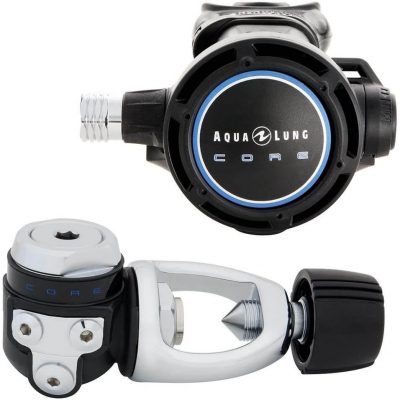
If you are thinking of buying a new scuba regulator or even thinking of replacing your old one, the Aqualung Core Supreme is definitely worth your consideration. This scuba diving tank regulator assures you of a superb breathing performance. This is coupled with many advanced features to ensure that you get value for your money.
This Supreme version has been particularly designed for cold water diving and it is an ideal choice for the beginner divers, the intermediate ones and even the advanced ones. This regulator is lightweight so ensuring so that you can swing into action with less bulk.
This regulator has an Auto Closure Device (ACD) that automatically closes the regulators inlet the moment it is removed from the cylinder valve. This helps to keep all the corrosive water and other contaminants out. The ACD helps in maintaining the lubrication of the regulator’s internal parts therefore ensuring that it performs at its best and that it serves you for long.
It also features a heat exchanger that absorbs any heat from the surrounding waters and dispels the cold that is generated once the gas expands. The large Venturi switch that is easily adjustable even when wearing cold-water gloves prevents any unwanted free-flow on the surface when offering a high performance at lower depths.
The mouthpiece is uniquely designed to minimize jaw fatigue and it comfortably fits perfectly into your denture attaching itself on the top of your mouth. The clamp is reusable and the lip cover protects your lips from the cold underwater temperatures.
Aqua Lung Regulator Legend – Best Diving Regulator
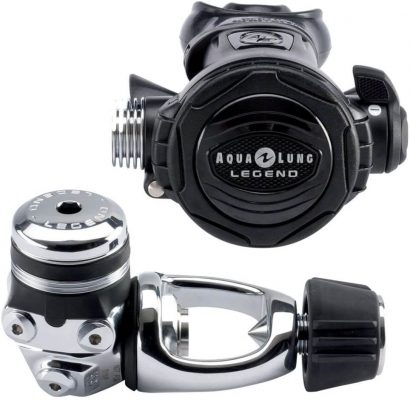
The Aqua Lung Regulator Legend is one of the best diving regulators in the market today. It is also a product of the renowned Aqua Lung brand that is known for making highly innovative and premier quality scuba gears.
This regulator is light and compactly built and it comes with very impressive features. It features an overbalanced diaphragm in the first stage that is uniquely designed to offer an exemplary breathing performance at depth. The Auto Closure Device ensures that the corrosive water does not enter the first stage inlet and that the internal lubrication is not washed away by automatically closing when the regulator is removed from the diving cylinder valve.
The over-sizes lip shield on the second stage helps in keeping your lips warm even in cold waters. The 2HP and 4MP ports are angled for an excellent hose routing. The environmental dry system helps in keeping water out of the main spring chamber therefore preventing any ice buildup and locks out any silt or contamination.
The innovative Master Breathing System (MBS) enables you to adjust the breathing performance of your regulator by controlling the direction of the air and by changing the opening effort. The Comfo-Bite mouthpiece with bitewings ensures that you do not suffer from jaw fatigue by perfectly fitting into your denture. Lastly, the heat exchanger that encircles the valve mechanism dissipated any cold that is results from gas expansion and the ergonomic exhaust tee relays bubbles out of your range of vision.
Scubapro MK25/S600 – Scuba Regulator
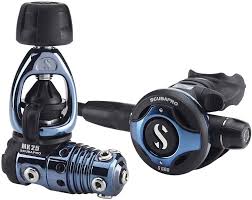
The Scubapro MK25/S600 is a product of one of the world’s most iconic brands Scubapro, which is famous for making premier diving equipments. This first and second stage regulator comes with a good number of innovative features.
It is a fully balanced regulator, which assures you of an excellent breathing performance regardless of water temperature, pressure or depth. This regulator is environmentally sealed and it has also been enhanced with coatings and finish on the internal parts for preventing any likelihood of an accidental free-flow. Even when diving in extreme temperatures such as ice diving, the first stage properties of this regulator ensure that the internal parts do not freeze up or malfunction.
When it comes to the second stage, this regulator has an inhalation control that regulates the breathing resistance through turning the control bezel to the side. This simply means that it either decreases or increases the breathing resistance by enabling you to adjust it based on your personal breathing resistance rate.
Another great feature of this regulator is the Bench Area Control where there is a pre dive and dive mode indications. By choosing the pre-dive mode, air is allowed back to the diaphragm minimizing the chances of free flow incidences and by choosing the dive mode, optimum air is allowed to flow freely out of the mouthpiece. Finally, the mouthpiece is designed with soft materials minimizes the chances of your jaws getting fatigued and the soft rounded edges ensures that you enjoy a comfortable mouth grip.
Palantic AS101 YOKE Diving – Dive Regulator & Octopus Combo
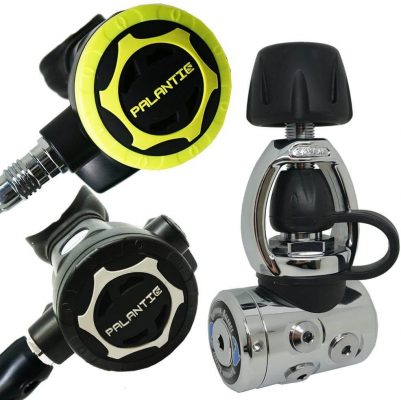
The Palantic AS101 YOKE is a premium quality scuba regulator that is designed with great features to give you an amazing breathing performance. The AS101 regulator combo package comes to you in a compact and lightweight setting to ensure that your underwater experience will not be hindered by unnecessary bulkiness.
The first stage regulator employs the use of an unbalanced flow by a piston that has a maximum working pressure of 3500psi. The four low-pressure ports then release the air at a low pressure of between 135psi to 145psi. It also comes with an environmental sealing that protects it against possible freezing in extreme water temperature, corrosion or contamination of internal parts.
When it comes to the second stage regulator, the Palantic AS101 YOKE is highly recommended to beginner divers. They do not need any adjustment on the airflow and all one is required to do is put on the mouthpiece and the air will just flow on demand and you continue inhaling.
This combo package also has its own alternate air source or octopus and a 36 inches yellow colored low-pressure hose. The alternate air source and the main second stage have a large purge button that is ideal especially for beginners since one need to just press on the button and the air will start to flow freely.
Mares MV Octopus – Dive Regulator
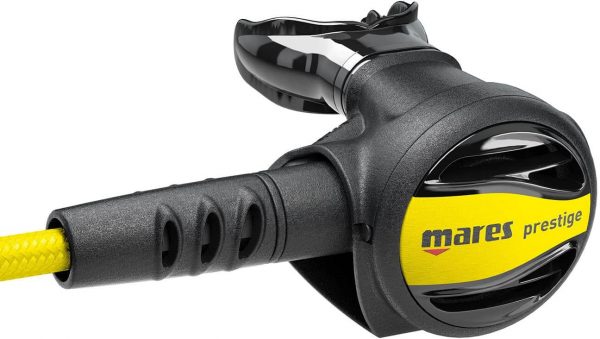
The Mares MV Octopus is a compact and light alternate air source that has been solely designed to be used as an alternative air source and not as a primary or main regulator. Unlike the most common regulators that are circular n shape, this one comes in a unique compact rectangular with soft edges on the sides.
The symmetrical shape of this regulator is for ensuring that it can be used from either the right or the left side. The internal design of this regulator employs the use of the Vortex Assisted Design, that arrange the internal parts in a way that they convey air towards the mouthpiece in rippling vortex of minimal pressure. This way, it forms a highly sensitive airflow that results to lower breathing resistance.
This design however has both a positive and a negative side. The positive thing about it is that the breathing resistance is kept at its lowest regardless of the depth. The negative side of this design is that if the slightest pressure is exerted on the diaphragm, for example, when you do a giant stride entry, it will make the regulator to free flow even when it is not in use or when it is still in the mouthpiece holder. This regulator is nitrox compatible although it should only be used when diving in warm waters and not in extreme temperatures such as ice diving.
Cressi XS Compact AC2 – Best Regulator
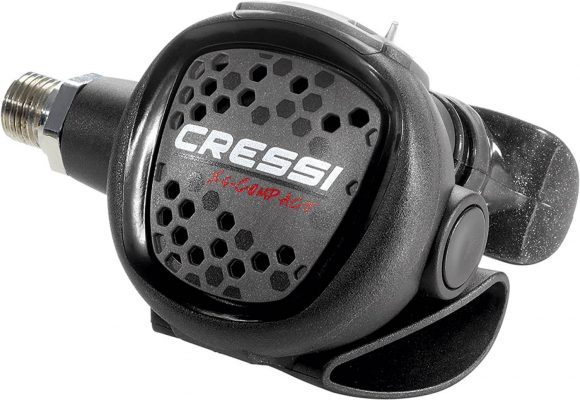
The Cressi XS Compact AC2 is a top scuba regulator that is known for its simple but sturdy features that makes it a low cost maintenance regulator. The first stage regulator is made from the durable marine chromed brass for longevity and durability.
It is also among the most affordable regulators that are currently in the market and an ideal option for the beginner divers. This first stage regulator is highly dependable with a non-balanced flow by piston design.
It is simply designed but yet it is fail-safe and it is able to deliver air even if that is first stage malfunction. The first stage features a single high-pressure port and four low-pressure ports. The first stage also uses a conical filter that has a larger surface area for a higher rate of airflow.
The second stage regulator is made of the durable and non-corrosive high quality polymers, and it has a reliable downstream demand valve mechanism. The airflow is conveyed to the mouthpiece through injection that creates a venturi effect that boosts the regulator’s performance.
The big and soft purge cover enables an easy clearing of the second stage and a silicone mouthpiece for comfortable breathing. Lastly, this regulator is very compact and lightweight adding to your convenience.
Mares Abyss 22 Navy 2 – Best Regulator
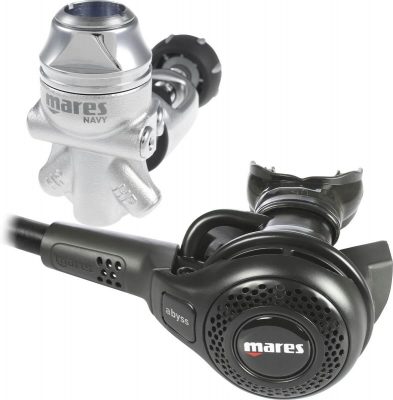
The Mares Abyss 22 Navy 2 is a premier regulator that is designed to match the US Navy standards. It is very robust and sturdy with an ability to withstand even the extreme temperatures such as ice diving. It offers you an outstanding breathing performance even in the toughest water conditions.
The CWD technology prevents water from entering from the spring cavity thus maintaining the airflow. The dynamic flow control system minimizes immediate pressure drop when inhaling so that you continue enjoying a constant air inflow.
The first stage has a balanced diaphragm that is made of chrome plated marine brass that ensures that the regulator is performing at its peak regardless of the depth. In addition, it does not allow any water to get to the inner mechanism. All the inner parts are environmentally sealed to protect them from corrosion and other contaminants.
The second stage features a patented Tri-material Valve Technology that helps the regulator optimize its performance and reliability. The valve is sealed with strong Polyurethane and the durable brass makes the second stage very durable.
The all-metal construction of the second stage prevents it from freezing because of the high thermal conductivity. The patented mesh design reduces the water flow impact even in strong currents and the Vortex assisted Design system creates a swirling vortex when air is channeled to the mouthpiece keeping the diaphragm down during inhalation.
Atomic T3 Titanium Swivel – Sealed Scuba Regulator
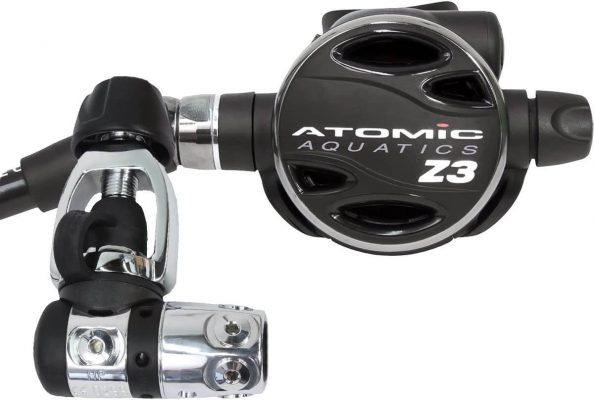
The Atomic T3 Titanium is without any doubts one of the best diving regulators that the market is currently offering. It is made of the strong Titanium that is ultra lightweight and it lasts for a very long time.
This regulator is ideal for use both warm and cold-water conditions and it can handle any kind of diving depth. It is fitted with a great seal system that enhances its anti-freezing ability. It is very compact and thus convenient for traveling and an excellent choice even for the high-end divers.
It comes with an Automatic Flow Control (AFC), it is very dependable and corrosion resistant and it will serve you for a long time. It is freeze protected and it is fitted with a reliable seat system. It is also durable enough to last for a period of three years or an equivalent of three hundred dives.
The first stage balances flow via a piston mechanism that enables the user to dive in any kind of depth. It is also freeze protected with premier quality sealing to prevent any entrance of contaminations in the inner mechanism. It has two high-pressure ports and five low-pressure ports, which are on the swivel turrent for an easy hose routing.
This incredible regulator is constructed using the solid titanium that is corrosion resistant and very light in weight. The second stage is a balances liner flow mechanism that makes breathing so effortless in any kind of a diving experience. The high flow design in this stage lowers the breathing efforts giving you a high and enjoyable breathing performance.
It also has an Atomic Patented Automatic Flow Control that controls the flow of air very efficiently, and the venturi effect makes sure of an optimum breathing resistance at all depths. The mouthpiece is made of durable silicone that is very comfortable in your mouth reducing any jaw fatigue.
The adjustable and over molded knob is soft to take off in situations when the diver experiences a pulling effect. The comfortable swivel provides for 30 degrees movements without any trouble. This regulator is nitrox compatible, adjustable and very convenient making it a great choice for any diver.
Genesis GS2000 – Best Scuba Regulator
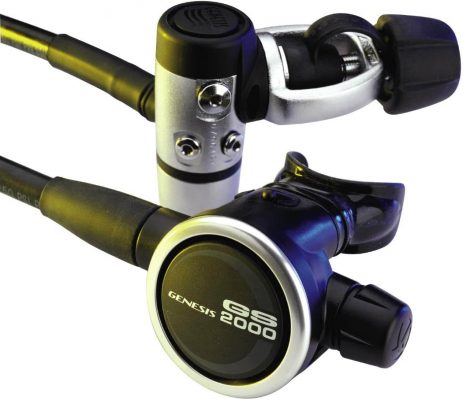
The Genesis GS2000 is an amazing regulator that is best known for its comfort and adjustability. This regulator comes with great features for both the first and the second stages. The regulator comes in a simple, yet unique design. It has a flow by piston that balances the first stage air ensuring an exemplary breathing performance at both full and low-pressure tanks pressures.
This balanced flow-by piston design is a ‘fail safe’ internal mechanism that has a dry seal that keeps the delicate inner parts clean and free of contaminants in any kind of a diving environment.
It is also made from the marine grade chrome plated brass for enhanced durability. The first stage regulator features the Dry Air Demand function that enables the regulator to increase the intermediary pressure without the use of oils or grease, as is the case with most regulators.
The first stage is also equipped with two high-pressure ports, three low-pressure ports, and a high capacity inlet filter that ensures a smooth conveyance of air to the second stage. This regulator’s second stage delivers air with minimal effort and the pre-dive or dive switch prevents unwanted free flow and removes sensitivity when surfing or when jumping off a boat but at the same time delivering a great breathing performance when required to.
The second stage regulator is made from non-corrosive ABS/Polycarbonate stainless steel and the breathing resistance can be adjusted for optimum resistance. The mouthpiece is very comfortable and does not cause any jaw fatigue.
Genesis S.K.O. – Dive Regulator
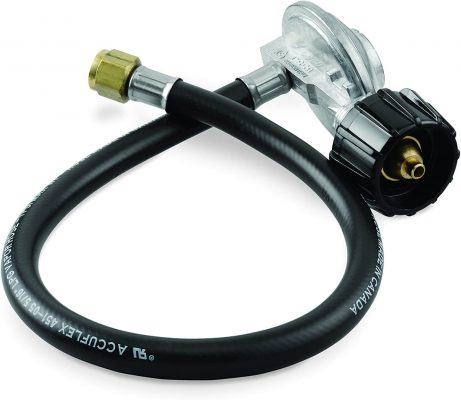
The Genesis S.KO is an alternate regulator for scuba diving that has been designed to offer you the great reliability just as the primary regulator. It has a compact design and it comes in a streamlined flat design that helps it fit perfectly and comfortably in either of your hands. It is therefore convenient for any user. It is also made with durable ABS plastic that is also lightweight ensuring that you enjoy a less cumbersome dive.
The bright yellow soft purge cover of the octopus makes its identification very easy. The silicone mouthpiece is long lasting and very comfortable in your mouth so that you do not suffer jaw fatigue. It is tuned or designed to reduce chances of unwanted free flow.
This octopus offers a breathing performance that is comparable to that of a standard main regulator and it comes with sensitivity adjustment for full control. It is very easy to clean and it is a low-cost maintenance gear. The regulator features four low-pressure ports and it has a very dependable downstream main valve.
How Diving Regulators Work
Diving regulators decreases tank force in two stages. The first stage of pressure decrease is from the tank to an intermediate pressure (of 7 to 10 bar), which is more than that of the water pressure around you. The second stage starts from the midway pressure to ambient pressure, which is similar to the water around you. These two stages are important to make your breathing comfortable.
Let us discuss these two stages in details.
First stage regulator
Diving tanks have compressed air, which is of high pressure of around 3000 pounds per square inch (psi). If you breathe directly from the tank, your lungs would collapse due to high pressure. That is why there is a piston or valve in the first stage to reduce this pressure to around 140 psi to disperse it to the hose.
The two major importances of diving regulators are to decrease the pressure level coming from the tank to make it safe to inhale, and it provides air whenever you need it. The control device opens up for air to get into the hose and eventually closes. Whenever you use the air in the tank, the regulator compensates it.
The regulator works like this:
When you breathe, the pressure from the intermediate chamber lowers to a level lower than the water pressure. Hence, the pressure in the water pushes inward, which opens the piston or valve. The open piston joins the high-pressure chamber to the intermediate-pressure chamber where air runs inside it. This raises its pressure to a level equal to the one in the ambient water. As a result, the piston or valve closes and this process repeats itself.
Second stage regulator
The second stage regulator contains a purge button, mouthpiece, exhaust valve and an inner valve joined to its changeable lever. It has a plastic compartment, which has a rubber diaphragm on the outside and it connects to the ambient water pressure.
The second stage works like this:
When you breathe you reduce the pressure in the 2nd stage to make it same as the one in the ambient-water pressure. As a result, the water-pressure compresses in on the diaphragm-membrane, which shifts the lever.
This shift on the lever makes the inlet-valve to open. Hence, air flows inside the 2nd stage from the 1st stage. Accordingly, the air will move to your lungs via the mouthpiece. When you breathe out, the pressure in the 2nd stage goes beyond the ambient-water pressure. As a result, the increased pressure goes out on the membrane.
The membrane will shift, which will make the lever to take its original location and the inlet-valve will close. When the pressure in the 2nd stage rises, the exhaust valve will open. The opening will let the breathed out air to get out of the 2nd stage. This process reoccurs whenever you inhale while diving.
You should clean your diving regulators after every dive to remove debris, silt and salt water. Such elements can hinder proper movements of membranes and valves or even corrode them. This is a precautionary measure that you should take for your regulators to work perfectly.
Types of Diving Regulators- What is the best regulator for scuba diving
Modern diving regulators are designed in different technologies, materials, sizes, shapes and styles. They also come with prices depending on the intended purpose and quality. Professional instructors and dive retailers go for the highly detailed regulators.
It is important that you buy from the online marketplaces or from a specialist dive store so that you can be advised accordingly. There, you can seek more advice about the features of a regulator, their models, styles and how you will benefit from them.
Regulators differ in terms of their performances during the first stage.
Unbalanced regulators
The term implies that the 1st stage will utilize tank pressure, partially, to open its inner valve. It implies that whenever you use the air inside the tank, you increase the breathing effort needed to unlock the valve. If you are diving at a depth of a hundred feet, your breathing effort will be marginally low but you will not notice it. However, a technical or an advanced diver might notice this difference because of the increased water pressure.
The unbalanced version of a scuba tank regulator is the most commonly used. It is ideal for people who do not dive over 20 meters. It has a DIN or INT feature that will help you to fasten the cylinder.
Balanced regulator
The first-stage styles do open or “crack” without aid from tank pressure. This makes it easy for you to breath all the time when you dive. Since this regulator type seems easy to use, it might be quite costly. However, it is ideal for people who do many activities when they dive or those who go for the deep dives.
Unlike the unbalanced style, the balanced regulator is best for diving more than 20 meters deep. Likewise, it has INT and DIN feature. You can get a balanced regulator designed just for your diving preference. For instance, you can get the one with anti-freeze features and it will be ideal for diving in cold water. Alternatively, you can get a regulator with venture effect. This will make your breathing easy because it will accelerate the air you breathe.
Diaphragm regulator or piston regulators
Diving regulators use piston or diaphragm to lower pressure coming from the tank during the first stage. Their functionalities are almost the same and they are perfect for recreational diving.
However, these two types are different in a few ways
Diaphragm regulators
These have 2 pieces to their valve-opening device – lever in an air-space, and a diaphragm which pushes inward when air-space contracts due to high external pressure. Such styles prevent the regulator from coming into direct contact with water.
As a result, the regs are resistant to water with elements like salt, silt and sand. The designs also can withstand cold because its inner pieces are covered. That is why you will find that many diving instructors use first stage styles because they require minimal care to handle.
Piston regulators
Unlike the diaphragm regulators, the piston ones cannot resist salt, sand, silt and cold as their inner pieces are uncovered. Piston regulators are simple and basic. This makes them ideal for shallow divers.
There will be no worry of damage since shallow divers use piston regulators in clean and warm water. Most importantly, the piston diving regulators are sold with an environmental seal kit, which guides the user on where and when to use them.
Tips for buying diving regulators
Diving safety
There are brands designed to offer high safety levels for diving regulators. Manufacturers ensure that every model of regulator goes through thorough testing.
They put different prices on these regulators depending on their features and styles. You should take time to evaluate the price and these features/styles.
When buying, you should note that expensive diving regulators do not really imply that they are better or safer than the rest. Many aspects determine the price of a regulator. Select the one with the features that are most suitable for your diving needs such as cold water, cave or professional diving.
Unbalanced and balanced regs for shallow or deep diving
Balanced regulators enable divers to inhale continuously and evenly all through, regardless of the elements in the water. This style is ideal for people who dive in serious depths and for technical divers, which makes them quite pricey. If you are one of them, you can consider investing in a balanced scuba regulator.
The unbalanced diving regulators are ideal for shallow divers and those who dive in clean water with little elements. You should not buy this one for deep diving. This is because they inhale unevenly when you share air either when its tank pressure reduces or at depth. However, they are easy to manage and maintain.
Regulator care and maintenance
This makes diaphragm regulators perfect for depth divers because they can withstand all weathers. This aspect of surviving in stiff weather makes diaphragm regulator to last long. On the contrary, diaphragm regulators are quite expensive and require regular service. If you want a regulator to dive in salty or cold water, you can buy a diaphragm type.
Since a piston regular has only a single moving part, it is easy and cheap to service. However, this is disadvantageous because some water enters during the first stage. This means you will take care of it constantly to secure it from deterioration. The regular service and intense care makes a piston dive regulator more durable than a diaphragm one.
Types of diving
Why do you need a scuba tank regulator? Your answer is a guide when selecting the quality and type of regulator that suits your need. If you dive in deep and cold water, a high-end type with additional features would work just fine for you. Alternatively, if you like to dive in clear or warm water you can go for a low-end regulator. Therefore, you should consider your current type of diving and the one you want to participate in the future.
Dive regulator price
Many regulators in the market differ in price and features. This factor goes hand in hand with the type of diving you want. This means a scuba reg with lots of features might cost more, but it will serve you more diligently than one without these features.
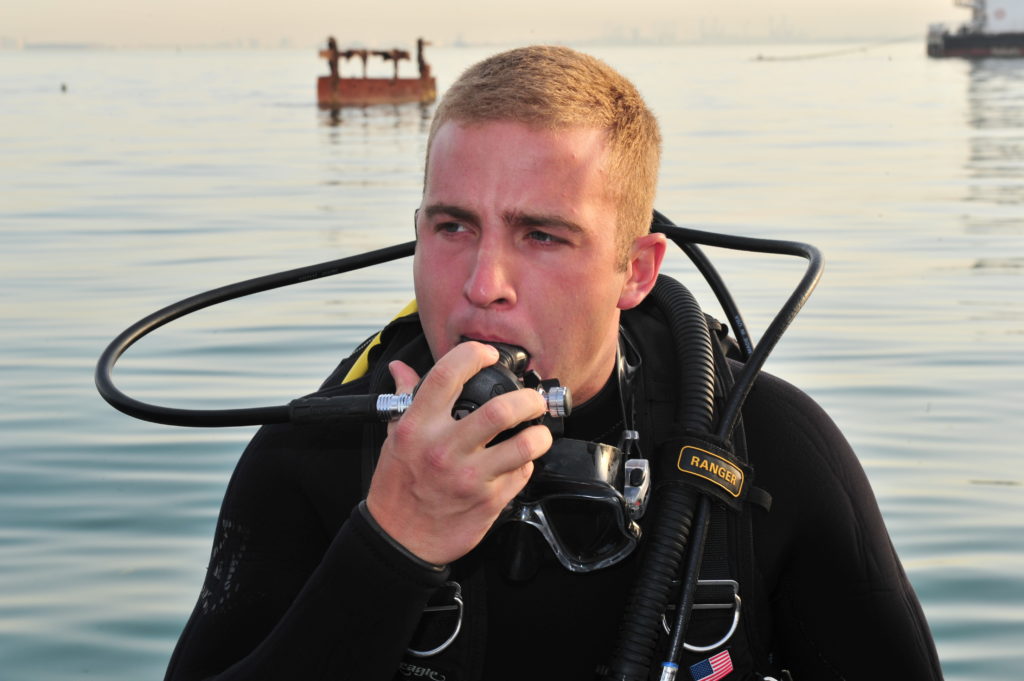
Frequently Asked Questions for Diving Regulators
Must I buy a diving reg?
Yes. You cannot dive without one because the air in your scuba tank is virtually impossible to inhale if it is not regulated. Sometimes, you can rent a regulator especially if you are a random diver who dives maybe once or twice a year. However, if you are a full diving enthusiast and you like to dive every so often, buying your reg makes more sense than renting.
Can I get infections when I share diving regulators?
Well, in essence, you are asking whether you can share a dive regulator with your family and the answer is yes. Many people are usually worried about infections or diseases that they might acquire in case they share regulators. Well, there are no reported incidences related to infections caused by regulators sharing. Scuba dive regulators do not cause fungal, viral or bacterial infections.
How often should I clean and sanitize my gear?
It is important that you clean your regulator after you are done with your dive in the salty ocean. You should use non-ionic detergent (does not have hydrocarbons) and a scrub brush to clean your scuba regulator. Wash the inner side of the mouthpiece. This will eradicate gross contamination like saliva, seaweed, sand, dirt and mud from your regulator. Consequently, rinse your device with fresh water. Also, clean your regulator before storage.
Will my scuba regulator make me sink?
It is essential to control your buoyancy while diving. When you swim underwater, your body forms lift just like the one an aircraft’s wing creates. That is why you might sink if you pause. Your body requires little buoyancy when we swim continuously. Take deep breaths in case you get neutral buoyancy when swimming to avoid sinking.
What type of dive regulator suits me?
There are many regulators in the market, which makes it challenging for divers to pick the best. Well, you should buy the one that suits your needs. For instance, there are regulators for fun divers and some for professional divers. The best thing to do is to evaluate your needs for diving. You can refer to our buying tips to see the regulator that suits your needs best.
Conclusion
In this post, so many things arise. For example, you may be wondering whether buying a scuba regulator at a price of between $150 and $1000 is advisable while you can rent one at a low price. Well, this depends on your diving needs. One thing you know is that you cannot dive without the best diving regulator. With the information I have provided here, I hope you can now choose the best one. What is the best regulator for scuba diving for a beginner? Pick one here.
